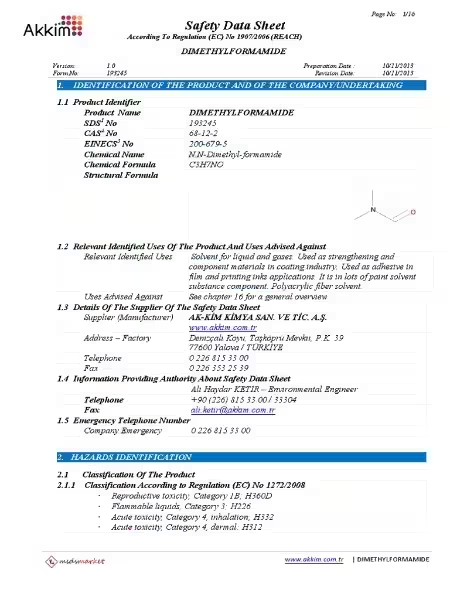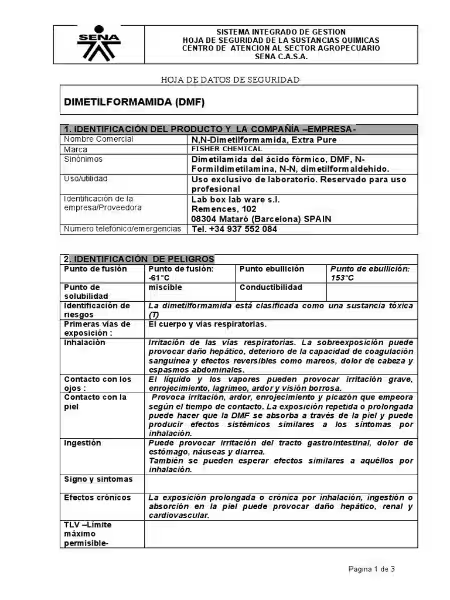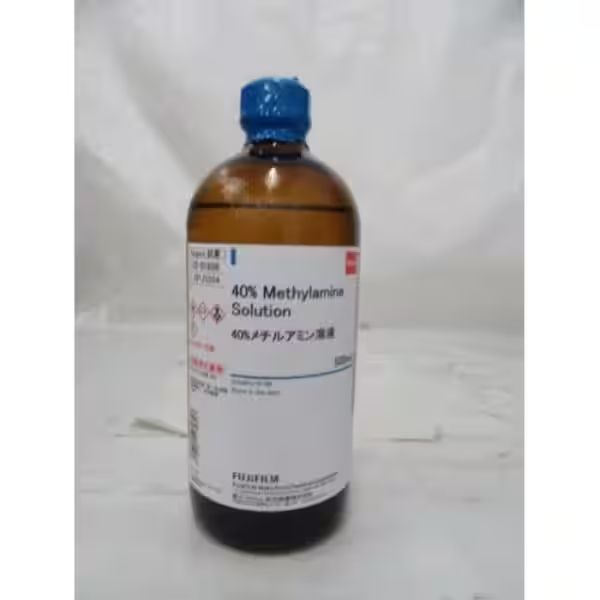Understanding the MSDS of DMF: A Comprehensive Guide

Dimethylformamide (DMF) is a versatile solvent widely used in various industrial and laboratory settings. However, its widespread application necessitates a thorough understanding of its potential hazards. This is where the Material Safety Data Sheet (MSDS) of DMF becomes crucial. This guide will delve into the key information contained within an MSDS of DMF, helping you understand its safe handling and potential risks.
What is an MSDS and Why is it Important for DMF?
A Material Safety Data Sheet (MSDS), now often referred to as a Safety Data Sheet (SDS), is a document that provides comprehensive information on the potential hazards associated with a chemical product, like DMF. It details the chemical's properties, potential health effects, and safety precautions to be taken during handling, storage, and disposal. The information contained within an MSDS of DMF is vital for ensuring the safety of workers, the environment, and the overall success of any operation involving this solvent.
The importance of understanding the MSDS of DMF cannot be overstated. Ignoring the safety precautions outlined in the MSDS can lead to serious health consequences, environmental damage, and legal repercussions. Responsible handling of DMF demands a complete and careful review of its associated MSDS.
Key Information Found in the MSDS of DMF
The MSDS of DMF typically includes several key sections providing critical information. These sections provide a complete picture of the chemical's properties and safety requirements. Let's explore some of the most important ones:
Identification Section: Understanding DMF
This initial section identifies the chemical, its manufacturer, and contact information. It clearly states the chemical name (Dimethylformamide), its synonyms (DMF), and its chemical formula (C₃H₇NO). This section also includes emergency contact numbers, vital for swift action in case of accidents.
This part lays the foundation for understanding what you're dealing with. Knowing the exact chemical name and contact information for the manufacturer is crucial in case of an emergency, allowing for rapid response and informed decision-making.
Hazard Identification: Recognizing the Risks
This section details the potential hazards associated with DMF. It outlines the health hazards, including acute and chronic effects. DMF is known to be absorbed through the skin, causing irritation and, in some cases, more serious health problems. Inhalation can also lead to respiratory irritation. The MSDS clearly states these risks and assigns appropriate hazard classifications according to globally harmonized systems (GHS).
Understanding the potential hazards is critical for implementing appropriate safety measures. This section details the severity and nature of potential health problems, enabling users to take necessary precautions like personal protective equipment (PPE).
Composition/Information on Ingredients: Knowing the Components
This part lists all the components in the DMF product, including their concentrations. While DMF itself is the primary ingredient, this section helps determine the presence of any additives or impurities that might affect its hazards. This helps to identify potential additional hazards and implement appropriate safety precautions.
This detailed breakdown of constituents is essential for understanding the overall risk profile. It allows for a more accurate assessment of potential hazards and tailored safety procedures.
First-Aid Measures: Responding to Exposures
This section provides clear instructions on what to do in case of accidental exposure to DMF, covering skin contact, eye contact, ingestion, and inhalation. It's crucial to follow these instructions precisely to minimize potential health risks. Each scenario has specific first-aid measures to ensure prompt and effective treatment.
This section is critical for emergency response. Knowing the appropriate first-aid procedures can significantly reduce the severity of potential injuries and health issues.
Fire-Fighting Measures: Handling Emergencies
The MSDS of DMF will offer guidance on how to extinguish fires involving DMF, detailing appropriate extinguishing agents and personal protective equipment (PPE) needed. This section is critical for fire safety protocols. DMF is flammable, and understanding how to safely deal with a fire involving it is crucial.
This section prepares you for potential fire-related scenarios, emphasizing the importance of preparedness and correct procedures.
Accidental Release Measures: Containing Spills
This section details the steps to take in case of a DMF spill, including containment, cleanup procedures, and waste disposal methods. Safe handling of spills is crucial to prevent further exposure and environmental contamination. Different spillage scenarios require different approaches.
Following these instructions diligently helps prevent environmental damage and ensures the safety of personnel involved in the cleanup process.
Handling and Storage: Safe Practices
This section describes safe practices for handling and storing DMF, including appropriate personal protective equipment (PPE), ventilation requirements, and storage conditions. Proper storage and handling are key to preventing accidents and maintaining workplace safety.
This section guides you on best safety practices and provides actionable advice to mitigate risks during routine operations.
Exposure Controls/Personal Protection: Protecting Workers
This section details the personal protective equipment (PPE) to be used when working with DMF (e.g., gloves, eye protection, respirators) and the engineering controls to be implemented (e.g., ventilation systems). It outlines the permissible exposure limits (PELs) and threshold limit values (TLVs) set by regulatory bodies like OSHA.
These details ensure the safety and well-being of individuals working with DMF. Adherence to these guidelines minimizes the risk of exposure to harmful levels of DMF.
Physical and Chemical Properties: Understanding DMF's Characteristics
This section provides detailed information on the physical and chemical properties of DMF, such as its appearance, odor, boiling point, melting point, density, and solubility. This information is essential for safe handling and storage.
This section allows for a comprehensive understanding of the chemical's behaviour and properties, facilitating informed decisions on safe handling and storage procedures.
Stability and Reactivity: Predicting Reactions
This section describes the stability of DMF under various conditions and outlines any potential hazardous reactions that could occur. Knowing the reactivity profile helps prevent accidents.
Understanding the reactivity of DMF helps in predicting potential hazards and designing appropriate safety protocols to prevent dangerous reactions.
Toxicological Information: Health Effects
This section provides detailed information on the health effects of DMF exposure, including acute and chronic effects, routes of exposure, and target organs. It's crucial for assessing the risks associated with DMF handling.
This is a critical section for understanding the health impacts of DMF and developing effective preventative measures.
Ecological Information: Environmental Impact
This section describes the potential environmental impacts of DMF release, including its effects on aquatic life and the environment. Understanding this is critical for responsible disposal and minimizing environmental harm.
This section highlights the importance of proper disposal methods to minimize the negative impacts on the environment.
Disposal Considerations: Responsible Waste Management
The MSDS of DMF details appropriate methods for disposing of waste DMF and contaminated materials. Following these guidelines is crucial for responsible waste management and environmental protection.
This section guides you on environmentally sound disposal methods, minimizing potential pollution.
Transport Information: Safe Transportation
This section describes safe transportation methods for DMF, including appropriate packaging and labeling. Adhering to these guidelines is crucial during transport to prevent accidents.
This ensures safe transport and minimizes the risk of accidents during transit.
Regulatory Information: Legal Compliance
This section outlines the regulatory requirements for handling, storage, and disposal of DMF, ensuring compliance with relevant local, national, and international regulations.
Compliance with regulations is critical for avoiding legal issues and ensuring responsible handling practices.
By carefully studying the MSDS of DMF and understanding the information presented, individuals can significantly reduce the risks associated with handling this valuable yet hazardous chemical. Always remember that safety should be the top priority when working with any chemical, and the MSDS is your primary resource for ensuring safe practices.
Since you haven't provided the content of the MSDS for DMF (Dimethylformamide), I cannot create an FAQ section based on its specific details. However, I can create a general FAQ section about what information is typically found in a DMF MSDS and what it means. Remember to always consult the specific MSDS for the DMF you are using, as details can vary slightly depending on the manufacturer and purity.
What is an MSDS (SDS)?
An MSDS, now more commonly called an SDS (Safety Data Sheet), is a document that provides comprehensive information on the potential hazards associated with a chemical and how to work safely with it. It's legally required for many chemicals, including DMF.
What are the main hazards associated with DMF according to its MSDS?
DMF MSDSs typically list several hazards. These commonly include: health hazards such as skin and eye irritation, potential liver damage from repeated or prolonged exposure, and reproductive toxicity; fire hazards as it is a flammable liquid; and environmental hazards due to its potential to pollute water sources. The specific details will vary depending on the MSDS.
What are the recommended personal protective equipment (PPE) when handling DMF?
Depending on the exposure level, PPE may include: gloves (typically nitrile or neoprene), eye protection (safety goggles or face shield), and respiratory protection (depending on concentration, a respirator may be necessary). Always refer to the specific MSDS for recommended PPE.
What first aid measures should be taken in case of DMF exposure?
First aid measures will vary depending on the type of exposure (skin, eye, inhalation, ingestion). Generally, this will involve removing contaminated clothing, flushing the affected area with copious amounts of water, and seeking medical attention. The MSDS will have specific first aid instructions.
What are the proper methods for handling and storing DMF?
Safe handling practices typically include working in a well-ventilated area, using appropriate PPE, and avoiding contact with skin and eyes. Storage should be in a cool, dry, well-ventilated area, away from incompatible materials and ignition sources. The MSDS contains detailed handling and storage instructions.
What are the spill and cleanup procedures for DMF?
Spill procedures generally involve containing the spill to prevent further spread, using absorbent materials to soak up the spilled DMF, and disposing of the contaminated materials according to local regulations. The MSDS will provide specific spill cleanup procedures.
How should I dispose of DMF?
DMF disposal must follow all local, regional, and national regulations. Never pour DMF down the drain. Proper disposal usually involves contacting a licensed hazardous waste disposal company. The MSDS may provide guidance on disposal but always check local regulations.
Where can I find the MSDS for the DMF I'm using?
The MSDS should be readily available from your supplier. It's usually included with the shipment or available online through the supplier's website.
This FAQ provides general information. Always consult the specific MSDS for the DMF you are using before handling it. The information provided here is for educational purposes only and does not constitute professional safety advice.








